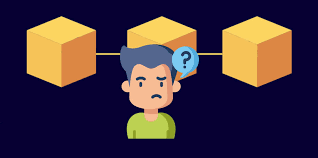What is blockchain?

Definition and explanation
Blockchain is a technology for storing and transmitting information, transparent, secure, and operating without a central control body (defined by Blockchain France). It is the technology at the heart of the Decentralized Web and its corollary, decentralized finance.

By extension, a blockchain constitutes a database that contains the history of all the exchanges made between its users since its creation. This database is secure and distributed: it is shared by its various users, without an intermediary, which allows everyone to check the validity of the chain.There are public blockchains, open to everyone, and private blockchains, access and use of which are limited to a certain number of actors.

A public blockchain can therefore be assimilated to a public, anonymous and tamper-proof accounting ledger. As the mathematician Jean-Paul Delahaye writes, imagine "a very large notebook, which everyone can read freely and for free, on which everyone can write, but which is impossible to erase and indestructible. "Locate the blockchain
The first blockchain appeared in 2008 with the digital currency bitcoin, developed by an unknown man using the pseudonym Satoshi Nakamoto. It is the underlying architecture.
If blockchain and bitcoin were built together, today many players (companies, governments, etc.) are considering the use of blockchain technology for other purposes than digital currency.
How it works ?
Any public blockchain necessarily works with a programmable currency or token. Bitcoin is an example of a programmable currency.
Transactions between network users are grouped together in blocks. Each block is validated by the nodes of the network called “miners”, according to techniques which depend on the type of blockchain. In the bitcoin blockchain this technique is called “Proof-of-Work”, proof of work, and consists of solving algorithmic problems.
Once the block is validated, it is time stamped and added to the blockchain. The transaction is then visible to the receiver as well as the entire network.
This process takes a certain time depending on the blockchain we are talking about (about ten minutes for bitcoin, 15 seconds for Ethereum).
The potential of blockchain
The decentralized nature of the blockchain, coupled with its security and transparency, promises much broader applications than the monetary domain.
The use of blockchain can be classified into three categories:
Applications for the transfer of assets (monetary use, but not only: securities, votes, shares, bonds, etc.).
Blockchain applications as a register: it thus ensures better traceability of products and assets.
Smart contracts: these are stand-alone programs that automatically execute the terms and conditions of a contract, without requiring human intervention once started.
The fields of operation are immense: banks, insurance, health and pharmaceutical industry, supply chain of many sectors (agri-food, luxury goods, international trade, distribution, wines, aeronautics, automotive, etc.), the music industry, energy, real estate, voting, etc.
Above all, blockchain paves the way for a new web, the decentralized web, and a new digital economy, the token economy. To understand what is at stake, it is crucial to avoid cartoons about cryptoassets, which are at the heart of this revolution.
Of course, these promises are not without challenges, be they economic, legal, governance, or even ecological.
This is why we at Blockchain France have chosen to approach blockchain technology from all angles, without bias, and without obscuring its limits.
➤ If you are an individual, we have put various publications online free of charge (sector studies, book, report, TEDx talks).
➤ If you are interested in blockchain for your business, Blockchain Partner, born from the merger between Blockchain France and Labo Blockchain, can support you through a tripole of expertise: training and advice; technical development; compliance.

